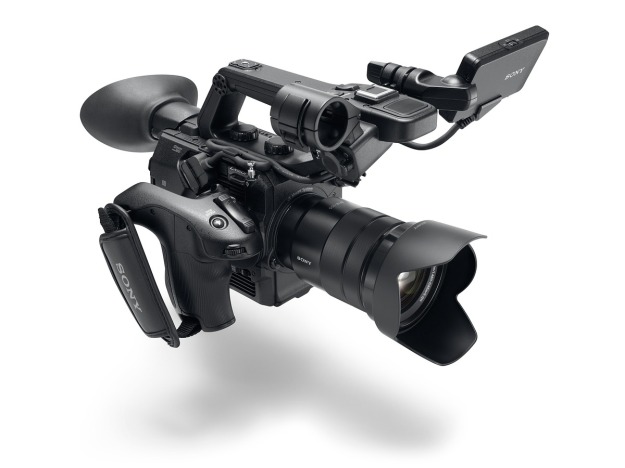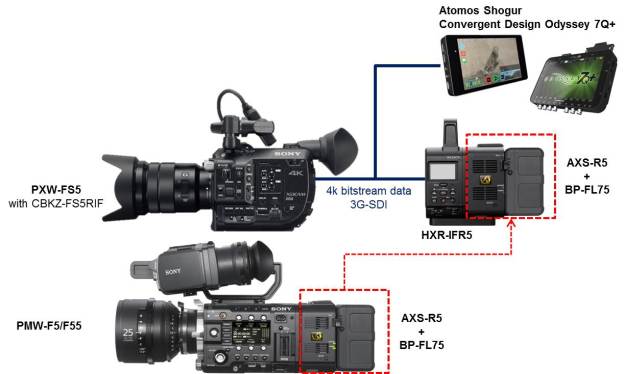Hi all again! Very exciting news these days…
Maybe you’ve just heard/read it in the typical NAB announcements or via social media ( https://youtu.be/WnitX19JZeo?t=2m50s ); the expected (and announced since the beginning) «FS RAW» upgrade for PXW-FS5 («CBKZ-FS5RIF») will be available soon. Very soon. So, let’s see what it means.

FS RAW? AND 4K? BUT… THAT’S A LOT OF BPS!
I’m sure some of you have heard, or, even better, have worked on NEX-FS700 and/or PXW-FS7. For you, this announcement will probably something «natural», and nothing that I’ll explain here will be really new.
As you may know, through a 3G-SDI interface (the main output, together with HDMI, in FS5) the maximum picture format that can be transmitted is 1080/50p (or 60p). However, it a 4K resoution needs to be sent, we would need a minimum of 6G-SDI connector.
However, this announcement (as years/months ago with FS700 and FS7), means that a 4K RAW signal can be delivered through that BNC connector. So… how????
In NEX-FS700, a little piece of hardware upgraded needed to be installed. In PXW-FS7, a camera adaptor needs to be attached to the camera body, XDCA-FS7. This time, for PXW-FS5, we simply need a firmware upgrade that can be done by end-user (but not as «simple» as a regular FW upgrade).
But those three models share the same kind of communication: through that BNC connector. Instead of sending the video in baseband, such video signal is converted into data and then encoded (under Sony proprietary protocol) and sent in data stream into the receiver.
OK, IT’S DATA, BUT HOW TO DECODE?
The first solution that existed for recording RAW from a FS700 was AXS-R5. However, R5 was a recorder that was mainly designed to be fitted in the rear part of PMW-F5 or PMW-F55. It receives signal from a multipin connector.
So, an intermediate hardware is needed: HXR-IFR5. This interface has a triple function:
- physical connection (it «emulates») the rear part of a F5/F55
- operation over R5: in F5/F55 operation is done via camera body. Here we’re missing such interface, so a set of buttons is needed.
- decoding FS RAW signal: as said, that data stream encoded under Sony protocol needs to be converted into «video signal», so that R5 receives it through its multipin interface.
This was the first way to record RAW from FS700, and it can be also used for FS7 and FS5. The only problem for some customers in this case could be the price: HXR-IFR5 + AXS-R5 + olivine battery + AXS memory + AXS memory reader can cost the same price (more or less) as the whole FS7.

So, some third-parties appeared; they held conversations with us, so that they could get access to the FS RAW protocol. Their typical workflow is to capture the FS RAW data stream and then convert it into a more «light» codec (despite it can also be RAW). They usually work over HDD or SSD drives, and use to provide also a monitoring solution. Obviously, the price is also smaller: about 1/4-1/3 of Sony’s solution. As you may have guessed, I was talking about Convergent Design with their Odyssey7Q/7Q+ recorder and also Atomos Shogun.
WHAT ELSE CAN BE ACHIEVED WITH FS5’s RAW UPGRADE?
Well, as you may expect from a camcorder that can reach up to 240 fps in Full HD, the FS RAW upgrade also improves the super slow-motion capabilities.
As you know, default super slomo feature in FS5 (and in FS7) works over a buffer. That’s why it is «cached»: about 8 seconds if shooting at 240 fps. Now, this «caché way» is only applied if we shoot 4K at 120 fps, in which we’ll have 4 seconds burst. That means that, if at 24p recording, we are shooting 120/24=5 times faster, which means that those 4 seconds are «time stretched» to 20 seconds. In 4K in RAW quality, not bad 😉
And regarding 240 fps, now there wouldn’t be time limitation if shooting in RAW; this means we can reach a «continuous» mode without caché.
According to my information, this upgrade will NOT be free of charge. Also, the procedure will be very similar to the one you should follow to convert your X70 into a 4K camcorder. Oh, and don’t forget you will need to update your FS5 into V2.00 (not available at the moment of publishing this entry) in order to be able to upgrade with CBKZ-FS5RIF.
Thanks for reading, and I really expect this little explanation is useful.
Regards!
Pingback: $600 Sony FS5 Raw upgrade to offer continuous external 4K/60fps and 1080/240fps Raw recording.
What did u mean by «the procedure will be very similar to the one you should follow to convert your X70 into a 4K camcorder» How exactly would I do the upgrade from home, will it as simple as giving Sony my serial and then give me a firmware download link and I click upgrade? after ive paid el dinero?? 🙂
Me gustaMe gusta
Yes… well, that’s the theory. In a practical term, you can see an entry here in my blog in which I detail the way to upgrade a X70 into 4K (I need to refresh the links) and, despite the user can do it in his/her own, actually there are some points in which waiting for response can be a bit disappointing (our fault).
But it is NOT as we did for FS700, in which you needed to send it to Alsace or Pencoed post-sale services to do a hardware upgrade. With FS5 you don’t need to open the camcorder to install any hardware piece.
Regards!
Me gustaMe gusta
Hi Alvaro, thanks for sharing.
You wrote:
«As you know, default super slomo feature in FS5 (and in FS7) works over a buffer.»
I think you meant the FS700? As far as I know, the FS7 doesn’t have a buffer and therefore can’t output a 4K 120fps RAW burst like the FS700. Also, is it absolutely certain that the FS5 will also be able to output this same 4K 120fps RAW burst just like the FS700? Thanks so much!
~Adam
Me gustaMe gusta
Yes, totally true: that «buffer mode» works the same in FS5 and in FS700. For a super slow motion we always need a buffer (maybe that’s what I wanted to explain and left it unclear). But in FS7 that buffer can be outputted in real-time, and it’s not limited to the quantities of time that I was mentioning.
To clarify: let’s assume that the super slow-motion «device» on FS5 is directly the same as that one in FS700.
Regards, and sorry for the misunderstanding I’ve caused.
Me gustaMe gusta
Thanks Alvaro! That’s no problem. Have a great day!
~Adam
Me gustaMe gusta
Everything is very open with a very clear explanation of the
issues. It was definitely informative. Your site is useful.
Thanks for sharing!
Me gustaMe gusta